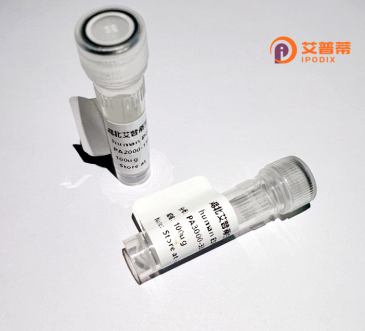
| 纯度 | >90%SDS-PAGE. |
| 种属 | Human |
| 靶点 | TRIM68 |
| Uniprot No | Q6AZZ1 |
| 内毒素 | < 0.01EU/μg |
| 表达宿主 | E.coli |
| 表达区间 | 1-485 aa |
| 活性数据 | MDPTALVEAI VEEVACPICM TFLREPMSID CGHSFCHSCL SGLWEIPGES QNWGYTCPLC RAPVQPRNLR PNWQLANVVE KVRLLRLHPG MGLKGDLCER HGEKLKMFCK EDVLIMCEAC SQSPEHEAHS VVPMEDVAWE YKWELHEALE HLKKEQEEAW KLEVGERKRT ATWKIQVETR KQSIVWEFEK YQRLLEKKQP PHRQLGAEVA AALASLQREA AETMQKLELN HSELIQQSQV LWRMIAELKE RSQRPVRWML QDIQEVLNRS KSWSLQQPEP ISLELKTDCR VLGLREILKT YAADVRLDPD TAYSRLIVSE DRKRVHYGDT NQKLPDNPER FYRYNIVLGS QCISSGRHYW EVEVGDRSEW GLGVCKQNVD RKEVVYLSPH YGFWVIRLRK GNEYRAGTDE YPILSLPVPP RRVGIFVDYE AHDISFYNVT DCGSHIFTFP RYPFPGRLLP YFSPCYSIGT NNTAPLAICS LDGED |
| 分子量 | 56.2 kDa |
| 蛋白标签 | His tag N-Terminus |
| 缓冲液 | PBS, pH7.4, containing 0.01% SKL, 1mM DTT, 5% Trehalose and Proclin300. |
| 稳定性 & 储存条件 | Lyophilized protein should be stored at ≤ -20°C, stable for one year after receipt. Reconstituted protein solution can be stored at 2-8°C for 2-7 days. Aliquots of reconstituted samples are stable at ≤ -20°C for 3 months. |
| 复溶 | Always centrifuge tubes before opening.Do not mix by vortex or pipetting. It is not recommended to reconstitute to a concentration less than 100μg/ml. Dissolve the lyophilized protein in distilled water. Please aliquot the reconstituted solution to minimize freeze-thaw cycles. |
以下是关于TRIM68蛋白的3篇参考文献的简要概括:
1. **《TRIM68 negatively regulates IFN-β production by degrading TRK-fused gene (TFG) protein》**
*作者:Li Y et al.*
**摘要**:研究发现TRIM68通过泛素化降解TFG蛋白,抑制RIG-I介导的I型干扰素(IFN-β)信号通路,从而负调控抗病毒免疫反应。
2. **《TRIM68 interacts with AGO2 to regulate antiviral defense through miRNA loading》**
*作者:Yang C et al.*
**摘要**:该文献揭示了TRIM68与AGO2相互作用,促进microRNA(miRNA)的装载过程,增强抗病毒反应中RNA诱导的沉默复合体(RISC)的功能。
3. **《TRIM68 promotes the K48-linked ubiquitination of TAB2 to modulate inflammatory responses》**
*作者:Wang H et al.*
**摘要**:文章指出TRIM68通过介导TAB2蛋白的K48连接泛素化修饰,促进其蛋白酶体降解,抑制NF-κB炎症信号通路的活化。
以上研究均聚焦于TRIM68在免疫调控中的作用,涉及泛素化修饰、干扰素通路调控及炎症反应等分子机制。
TRIM68. a member of the tripartite motif (TRIM) protein family, is characterized by its conserved N-terminal domain structure: a RING finger domain, one or two B-box domains, and a coiled-coil region. These domains enable TRIM68 to function as an E3 ubiquitin ligase, facilitating protein ubiquitination and modulating diverse cellular processes, including innate immunity, transcriptional regulation, and antiviral responses. TRIM68 is primarily localized in the cytoplasm and nucleus, where it interacts with multiple signaling molecules. Studies suggest its involvement in regulating pathways like MAPK/ERK and NF-κB, impacting cell proliferation, apoptosis, and inflammatory responses.
Notably, TRIM68 has been linked to immune regulation, particularly in viral infections. It interacts with viral proteins (e.g., from HIV-1 and influenza A) and host factors to either restrict or enhance viral replication. Additionally, TRIM68 plays roles in stress granule formation and mRNA metabolism under cellular stress. Dysregulation of TRIM68 is implicated in pathologies such as cancers, autoimmune disorders, and neurodegenerative diseases. In cancer, it exhibits dual roles—acting as a tumor suppressor by promoting oncoprotein degradation or as an oncogene via pro-survival signaling. Despite progress, its precise mechanisms and context-dependent functions remain understudied, necessitating further exploration of its therapeutic potential.
×